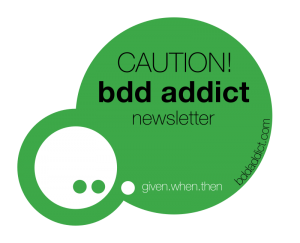The monthly dose for BDD addicts… The top 5 stories of 2018 by Gojko Adzic, the Cucumber team, Andy Knight, Chris Matts & John Ferguson Smart…
Subscribe to the monthly newsletter at http://bddaddict.com so that you never miss it! (Did you get the November-December issue?)

Dear BDD Addicts,
It is the middle of January already, but I still haven’t got used to writing 2019 instead of 2018. So probably it makes sense to look back what happened last year, which has been probably the busiest BDD year for me so far. And how else could we take a look back at the last year in the BDD addict newsletter than collecting the articles that proved to be the most popular among the readers. So here is our list and herewith I would like to thank to all the 45(!) authors who wrote those 52 articles, blog posts or useful Stack Overflow replies that we have shared.
I would like to encourage you to start or keep writing about BDD, agile testing and test automation, because there are so many people who would like to improve their knowledge or widen their view through them. And if you see an interesting article, please send the link to bddaddict@specfolutions.eu, so that I can share.
Let’s see what we liked the most in 2019…

[BDD] Given/When/Then on different levels
In the morning of the second day of CukenFest, I had a chance to have a coffee together with one of my well-respected mentors, Chris Matts. He is one of that guys whom I always learn something from. This time he was talking about applying BDD at different levels of the system. But these are not the pyramid levels we think about when we automate scenarios, but rather system design levels. Fortunately I don’t have to explain what he told me, because he recorded all the findings in a 4-part blog post series. It is not an easy read, but worth. This is the first post of the series.
BDD Done easy – The three levels of BDD (Chris Matts, @PapaChrisMatts)

[Test Automation] BDD for cleaner tests
In one of the past issues (damn, I can find it now which one), I have shared a post that was describing what benefits BDD-style testing can provide, even if you don’t have deep collaboration. I can’t repeat it enough times, how important it is to practice collaboration and requirement discovery. In spite of this fact it is good to have a look at what impact BDD makes for test automation. Andy Knight shared his thoughts about that.
Why choose BDD over other test frameworks? (Andrew Knight, @AutomationPanda)

[Agile] Sustainable products: Sprints vs. marathons
Probably when you hear about sprints and marathons in the context of software development, you would think about the classic waterfall vs. agile discussion. Sprints represent the agile iterations and marathons the long waterfall ones. It is what we have learned from the running metaphor. But wait! How many sprints can a runner run without having a rest? A recent article by Gojko Adzic digs into this metaphor to understand how we can deal with code maintenance, refactoring story and other technical improvements in an agile project.
Sprints, marathons and root canals (Gojko Adzic, @gojkoadzic)

[BDD] Scenarios of scenarios
BDD is a collaborative approach, but in many cases the automation aspect of it is led by developers or test automation engineers. As these people are used to work with programming languages, they tend to see BDD scenarios and Gherkin language also as a programming language, so they try to apply the same principles they use for coding. But these principles are not necessarily applicable there. John Ferguson Smart focuses on one of these problems in his post: how can we reuse Gherkin scenarios.
How can I reuse my gherkin scenarios? (John Ferguson Smart, @wakaleo)

[BDD] BDD Under Pressure
The Cucumber team has a long history of teaching good BDD habits by showing the mistakes that teams usually do. (Do you remember the “Cucumber anti-patterns” articles?) This time they are focusing on team and project issues that make the successful adoption of BDD harder or even impossible. There are 10 points listed as it should be in a “10 things…” article, but my favorite is the pressure. I know it from teaching… an exam at the end of the course makes the learning process less efficient, because they will focus on — what a surprise — passing the exam, instead of learning new things that they might be able to use. Keep up the sustainable pace and read the tips for BDD adoption from the Cucumber team.
10 easy ways to fail at BDD (Cucumber team, @cucumberbdd)


Upcoming SpecFlow, BDD Vitals and Cucumber courses
- BDD Vitals, 20 March 2019, London (UK)
- BDD with SpecFlow for devs & testers, 20-22 March 2019, London (UK)
- BDD Vitals, 22 May 2019, Budapest (HU)
- BDD with SpecFlow for devs & testers, 20-22 May 2019, Budapest
My SpecFlow, BDD VItals, Cucumber, Robot Framework, XP Today, TDD Today and TFS courses are also available as private training. Contact for details.

